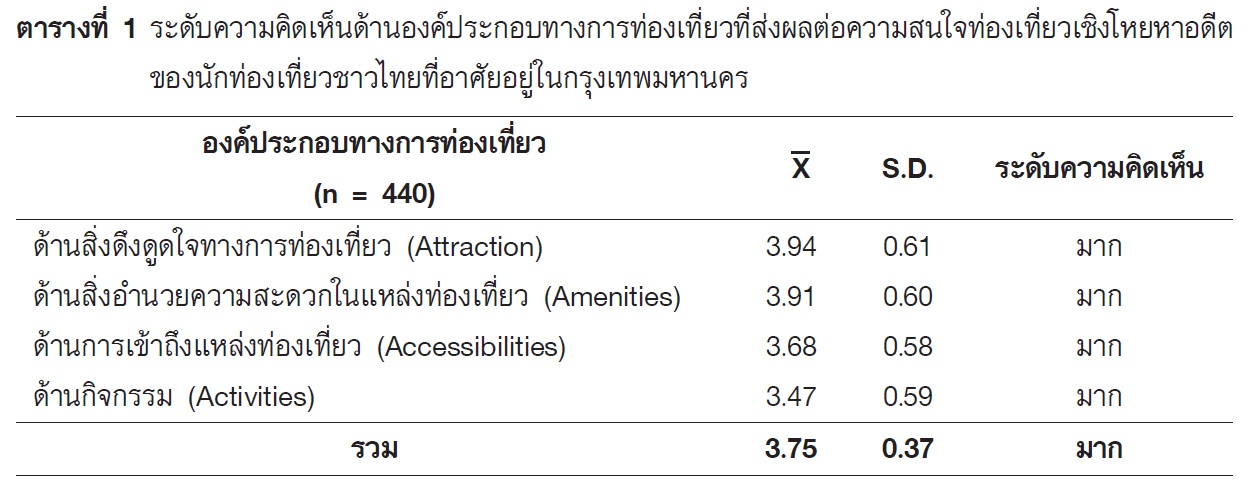COMPONENTS OF TOURISM AFFECTING THE INTEREST IN NOSTALGIC TOURISM OF THAI TOURISTS BASED IN BANGKOK
Main Article Content
Abstract
Purpose : To study components of tourism include Attraction, Accessibility, Activity and Amenity which affect the interest in nostalgic tourism of Thai tourists who live in Bangkok and to compare their demographic attributes: gender, age, education level and income
Methods : The sample consisted of 440 Thai tourists who were 20 years old and above, live in Bangkok in the districts of Chatuchak, Bang Khen, Sai Mai and Bang Khae, and were experienced in visiting nostalgic tourism destinations. This research adopted a purposive and quota sampling technique using questionnaires as the main method to collect data with the IOC of 0.76 and coefficient alpha at 0.92. This study also applied statistical data analyses such as the frequency, percentage, mean and standard deviation. The data were also analyseed using One-Way ANOVA and multiple linear regression with statistical significance at 0.05
Results :
1. The sample had a high level of opinion towards overall tourism component (X = 3.75, S.D.= 0.37). When individual aspects were considered, an aspect with the highest mean was attraction, followed by amenities, accessibilities, and activities, respectively.
2. The sample had a high level of interests in nostalgic tourism (X = 3.96, S.D.= 0.58). When individual aspects were considered, an aspect with the highest mean was interests in nostalgic tourism due to the needs for nostalgic feeling and experience (X = 4.22, S.D.= 0.90), followed by the needs for taking photos in outstanding and beautiful nostalgic tourist sites (X = 4.20, S.D.= 1.11), the needs for building the relationships with family members or friends (X = 3.87, S.D.= 1.20), the needs for temporarily escaping from disturbances (X = 3.82, S.D.= 1.11) and the needs for learning activities and traditional culture (X = 3.67, S.D.= 1.33), respectively.
3. A demographic factor influencing tourists’ interests in nostalgic tourism was age with a statistical significance level of .05
4. Two components of tourism influencing tourists’ interests in nostalgic tourism were attraction and amenity with a statistical significance level of .05
Conclusion : Different demographic age affected different interests in nostalgic tourism, while Thai tourists who have different gender, income and education level had no difference in interest in nostalgic tourism. Moreover, the attraction and amenity components of nostalgic tourism were the main factors that affected Thai tourists who are interested in nostalgic tourism.
Article Details
References
Bangkokbiznews. (2018). “BuppeSanNiWat Fever” because the Thai people longed for the past, just lacking the art of telling. (Online). Retrieved April 8, 2018, from: http://www.bangkokbiznews.com/news/detail/796495.
BMA data center. (2015). Statistics of population and houses in Bangkok classified by Cases and districts 2015. (Online). Retrieved September 13, 2018, from http://203.155.220.230/bmainfo/esp/pop/pop_58.pdf.
Buhalis, D. (2000). Marketing the competitive destination of the future Marketing. Tourism Management, 21 (1), 97-116.
Creighton, M. (1997). Consuming Rural Japan: The marketing of tradition and nostalgia in the japanese travel industry. Ethnology, 36(3), 239-254.
Goossens, C. (2000). Tourism information and pleasure motivation, Annals of Tourism Research. 27(2), 301-321.
Davies. (2007). Nostalgia tourism’ uncovered as new trend. (Online). Retrieved April 1, 2019, from http://www.travelmole.com/news_feature.php?id=1124918.
Dumrongsri, S. (2011). Satisfaction of Thai tourist towards conservative at Sam Chuk 100 Years Market, Suphanburi province. Master’s Thesis, Recreation Management, Srinakharinwirot University. Bangkok.
Jittangwatana, B. (2006). Sustainable tourism development. Bangkok: TAT Academy.
Khemrat, C. (2014). Factors affecting decision marketing behavior towards tourists on man-made tourist attractions; a case study of Cha-am district, Petchaburi province and Hua-hin district, PrachuapKhiri khan province. Master’s Thesis, Stamford international University. Bangkok.
Kitiasa, P. (2003). Anthropology and the study of the past yearning phenomenon in contemporary Thai society. Bangkok:Anthropology Center.
Salinas, A., Buckley, R. and Morales, R. (2016). Economic Development and Nostalgic Tourism in Southern Mexico. Hatfield Graduate Journal of Public Affairs, 1(1), 1-15.
Middleton, V.T.C. (1994). Marketing in Travel and Tourism. (2nd Ed). Oxford: Heinemann Professional Publishing.
Ministry of Tourism and Sports. (2018). Statistics of domestic tourists in Thailand, 2018. (Online). Retrieved August 8, 2018, from https://www.mots.go.th/more_news.php?cid=502&filename=index.
Prakitnonthakran, C. (2014). Retro market in nostalgia tourism. TAT Tourism Journal 2, (2557): 20-25.
Praditrod, C. (2016). Components of Tourist Attractions and Tourism Motivation Affecting to Working People’s Decision Making to Travelling in Vicinity Areas. Master’s Thesis, Graduate School, Bangkok University. Bangkok.
Pumma, N. and Rodsup, N. (2013). Nostalgia in Thai tourism industry. Institute of Mekong Salaween Civilization Studies Journal, 3(Special issue), 47-60.
Robinson, P. (2015). Conceptualizing urban exploration as beyond tourism and as anti-tourism. Advances in Hospitality and Tourism Research, 3(2), 141-164.
Tanitnon, M. (2017). A study of motivations and satisfaction of Thai tourists visiting Baan Bang Khen. Master’s Thesis, Bangkok University. Bangkok.
Tourism Authority of Thailand. (2017). Amazing Thailand Tourism Year 2018. (Online). Retrieved August 8, 2018, from https://thai.tourismthailand.org.
Wongvanit, V. (2003). Tourism geography.(2nd Ed). Bangkok: Thammasat University.


